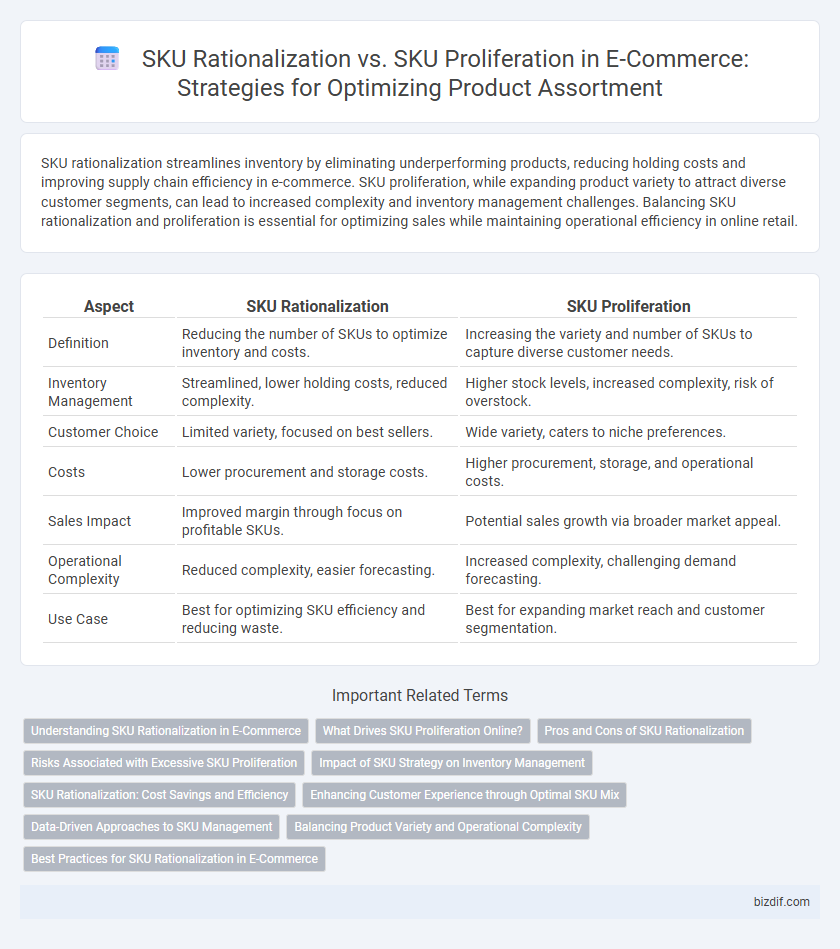SKU rationalization streamlines inventory by eliminating underperforming products, reducing holding costs and improving supply chain efficiency in e-commerce. SKU proliferation, while expanding product variety to attract diverse customer segments, can lead to increased complexity and inventory management challenges. Balancing SKU rationalization and proliferation is essential for optimizing sales while maintaining operational efficiency in online retail.
Table of Comparison
| Aspect | SKU Rationalization | SKU Proliferation |
|---|---|---|
| Definition | Reducing the number of SKUs to optimize inventory and costs. | Increasing the variety and number of SKUs to capture diverse customer needs. |
| Inventory Management | Streamlined, lower holding costs, reduced complexity. | Higher stock levels, increased complexity, risk of overstock. |
| Customer Choice | Limited variety, focused on best sellers. | Wide variety, caters to niche preferences. |
| Costs | Lower procurement and storage costs. | Higher procurement, storage, and operational costs. |
| Sales Impact | Improved margin through focus on profitable SKUs. | Potential sales growth via broader market appeal. |
| Operational Complexity | Reduced complexity, easier forecasting. | Increased complexity, challenging demand forecasting. |
| Use Case | Best for optimizing SKU efficiency and reducing waste. | Best for expanding market reach and customer segmentation. |
Understanding SKU Rationalization in E-Commerce
SKU rationalization in e-commerce involves analyzing product performance data to streamline inventory by removing underperforming or redundant SKUs, thereby reducing holding costs and improving supply chain efficiency. This process leverages sales metrics, customer demand patterns, and profitability analysis to prioritize high-performing products, ensuring optimal shelf space and enhanced customer satisfaction. Effective SKU rationalization supports better inventory turnover, minimizes stockouts, and strengthens overall operational agility in competitive online retail markets.
What Drives SKU Proliferation Online?
SKU proliferation online is primarily driven by retailers aiming to cater to diverse customer preferences and increase market share through extensive product variety. Factors such as the ease of digital listing, data analytics revealing niche demands, and competitive pressure to offer exclusive or differentiated products further fuel this expansion. This trend intensifies inventory management complexity and impacts supply chain efficiency, challenging e-commerce platforms to balance assortment breadth with operational costs.
Pros and Cons of SKU Rationalization
SKU rationalization streamlines product offerings by reducing redundant or low-performing SKUs, which improves inventory management and reduces carrying costs. This approach enhances operational efficiency and improves supply chain responsiveness but may limit customer choice and reduce market coverage. Effective SKU rationalization requires detailed sales analysis and customer insights to avoid losing valuable niche segments.
Risks Associated with Excessive SKU Proliferation
Excessive SKU proliferation in e-commerce leads to increased inventory holding costs, complex supply chain management, and higher risks of stockouts or overstocks. It amplifies demand forecasting inaccuracies, resulting in waste and reduced operational efficiency. Moreover, it dilutes marketing efforts and confuses customers, negatively impacting overall sales performance.
Impact of SKU Strategy on Inventory Management
SKU rationalization streamlines inventory management by reducing excess stock, improving turnover rates, and lowering holding costs. SKU proliferation increases product variety but often leads to higher complexity, increased carrying costs, and challenges in demand forecasting. Effective SKU strategy balances assortment breadth with inventory efficiency to optimize supply chain performance and profitability.
SKU Rationalization: Cost Savings and Efficiency
SKU rationalization streamlines product offerings by eliminating redundant or low-performing items, resulting in significant cost savings through reduced inventory holding, storage, and management expenses. This process enhances operational efficiency, improves supply chain agility, and optimizes inventory turnover rates. Businesses can redirect resources to high-demand SKUs, boosting profitability and inventory accuracy while minimizing stock obsolescence risks.
Enhancing Customer Experience through Optimal SKU Mix
Optimizing SKU mix through SKU rationalization streamlines inventory, reducing complexity and ensuring availability of high-demand products, which enhances customer satisfaction by simplifying choices and speeding delivery. SKU proliferation often leads to decision fatigue and slower fulfillment, detracting from the seamless shopping experience customers expect. Balancing SKU assortment based on data-driven demand insights and customer preferences maximizes both operational efficiency and personalized shopping journeys.
Data-Driven Approaches to SKU Management
SKU rationalization leverages data analytics to identify slow-moving or redundant products, optimizing inventory and reducing carrying costs. In contrast, SKU proliferation employs customer behavior and sales trend data to expand product variety, aiming to capture diverse market segments. Effective data-driven SKU management balances these strategies by analyzing demand patterns and profitability metrics to maximize e-commerce efficiency and customer satisfaction.
Balancing Product Variety and Operational Complexity
SKU rationalization reduces inventory costs by eliminating underperforming or redundant products, streamlining supply chain management and improving cash flow. SKU proliferation increases product variety, enhancing customer choice and competitive advantage but often leads to higher operational complexity, including increased handling, storage, and forecasting challenges. Balancing product variety with operational efficiency requires data-driven analysis to identify high-performing SKUs while minimizing those that dilute profitability and strain logistics.
Best Practices for SKU Rationalization in E-Commerce
Effective SKU rationalization in e-commerce involves analyzing sales data, customer demand, and inventory turnover to identify underperforming products for elimination or consolidation. Leveraging advanced analytics and AI-driven tools enhances decision-making by forecasting trends and optimizing assortment strategies. Maintaining a streamlined SKU portfolio reduces complexity, lowers carrying costs, and improves supply chain efficiency, driving higher profitability and customer satisfaction.
SKU Rationalization vs SKU Proliferation Infographic

 bizdif.com
bizdif.com